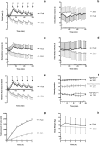Intravenous Fluid Challenge Decreases Intracellular Volume: A Bioimpedance Spectroscopy-Based Crossover Study in Healthy Volunteers
- PMID: 28851933
- PMCID: PMC5575097
- DOI: 10.1038/s41598-017-09433-5
Intravenous Fluid Challenge Decreases Intracellular Volume: A Bioimpedance Spectroscopy-Based Crossover Study in Healthy Volunteers
Abstract
The effects of intravenous fluid therapy on fluid compartments and hemodynamics of the human body remain enigmatic. We therefore tested the efficacy of bioimpedance spectroscopy in a crossover study, where 15 males received 0.5 ml/kg/min ELO-MEL-isoton (osmolarity = 302 mosmol/l) during 60 minutes, or nothing at all. In group "Fluid", fluid load increased from -0.2 ± 1.0 l extracellular volume at baseline to its maximum of 1.0 ± 0.9 l in minute 70, and remained continuously elevated throughout minute 300. In group "Zero", fluid load decreased from 0.5 ± 1.1 l at baseline to its minimum of -1.1 ± 1.1 l in minute 300. In group "Fluid", intracellular volume decreased from 26.8 ± 3.9 l at baseline to its minimum of 26.0 ± 3.9 l in minute 70, and remained continuously decreased throughout minute 300. In group "Zero", intracellular volume increased from 26.5 ± 3.8 l at baseline to its maximum of 27.1 ± 3.9 l in minute 120, and decreased thereafter. In group "Fluid" compared to "Zero", systolic blood pressure was significantly higher, from minute 50-90. In conclusion, intravenous fluid therapy caused a clinically meaningful, sustained increase in fluid load, and a decrease in intracellular volume. These data raise interest in studying fluid administration by the gastrointestinal route, perhaps even when managing critical illness.
Conflict of interest statement
The authors declare that they have no competing interests.
Figures


References
-
- In Intravenous Fluid Therapy: Intravenous Fluid Therapy in Adults in Hospital Vol. NICE Clinical Guidelines, No. 174 National Institute for Health and Clinical Excellence: Guidance, 3–46 (Royal College of Physicians (UK), 2013).
-
- Kamat, S. S. Practical Applications of intravenous fluids in surgical patients.,128–149 (Jaypee Brothers Medical Pub; 1 edition, 2013).
-
- Callum, K. G. et al. Extremes of Age: The 1999 Report of the National Confidential Enquiry into Periopeartive Deaths. London: National Confidential Enquiry into Perioperative Deaths, 1999. http://www.ncepod.org.uk (1999).
MeSH terms
Substances
LinkOut - more resources
Full Text Sources
Other Literature Sources

